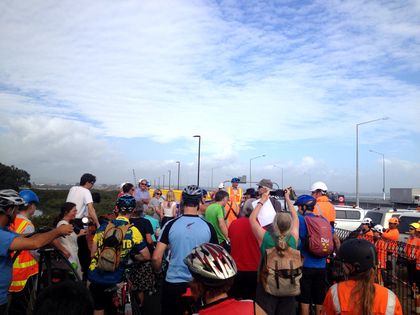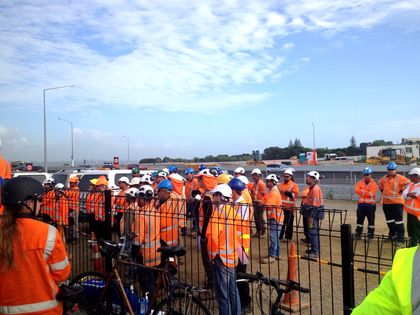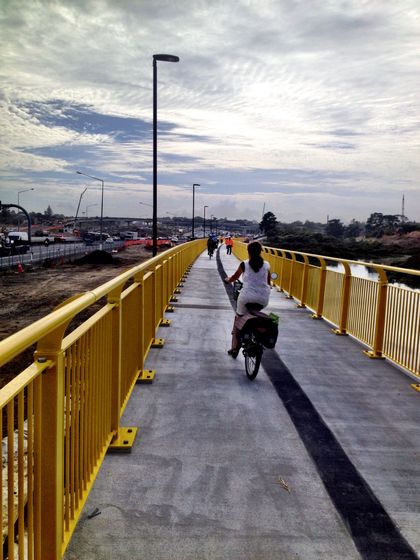Hard News: Works in progress
82 Responses
First ←Older Page 1 2 3 4 Newer→ Last
-
Physical separation by a barrier is better but cycling lanes that are just marked are still a good start. Where they occur I’d usually rather have them than not have anything.
I agree, separation can be as simple as a line of those orange knock down lane marker thingies with the reflectors on them stuck every 5-10m on the traffic side of the painted cycle way.
-
Bart Janssen, in reply to
why does it have to be so hard for something we are entitled to
I guess since we want to ride underneath the Newton Rd bridge we have to deal with the troll. Sigh.
-
Russell Brown, in reply to
But imagine if a subsidised “government” electric bike was available at the Warehouse for, say, $250. For a lot of people, those show stoppers would vanish. For hilly and windy NZ, mass adoption of electric bikes could be a Kiwi solution for Kiwi terrain.
I popped in on the people hiring out electric bikes on Waiheke yesterday. That's certainly a great solution for the island -- especially once they're able to get a presence down at Matiatia. I was quite impressed by the variety of bikes available too -- from converted mountain bikes to purpose-built cycles.
-
Russell Brown, in reply to
I noticed yesterday that somebody has, in fact, beaten a path through the trees between Ian McKinnon and Suffolk Street – there was a guy riding a bike over it… of course I would never endorse local PAS’ers getting out with pruning shears to make it more usable as a genuine shortcut…
I'm game. It's a public park so I sort of own it ;-)
-
Bart Janssen, in reply to
overwhelmingly roads for cars and trucks
This is an interesting point. Most people, and apparently planners as well, view roads as existing for cars and trucks. Yet this is incorrect.
Roads do NOT exist to transport cars and trucks.
Roads exist to transport people and goods.
When you views roads as tools to transport people and goods then your view of the value of cycleways and busways becomes quite different.
I do love the freedom our car gives us but I also suspect that there may well be better options in the not too distant future.
-
Bart Janssen, in reply to
Auckland’s hills are the essentially the gap between reality and the nice things people say about cycling infrastructure in Amsterdam, New York or London.
It would be nice if the folks planning the alternate cycle routes East and West of Dominion road had ever actually ridden a bike. We have two routes with bumps and stops weaving through side streets. One side makes you go up and down the whole route. the other actually takes you on to Dominion rd for part or the "alternate" route!?!
Had someone who actually ever rode a bike been involved they could have said "look forget about the hilly side, no cyclist will ever bother with it, instead spend all the money on the flat side and make it genuinely viable" by say making all those streets one way and having half of each road a proper two way smooth flat cycle path. Put stop signs on the cross streets so the cycle route has right of way instead of demanding the cyclist stop every 500m and lose all momentum.
As it is, a shit load of money has been spent on two cycle routes that are largely useless.
signed
grumpy old man of Mt Roskill -
Russell Brown, in reply to
This does sound like a proper mess.
Put stop signs on the cross streets so the cycle route has right of way instead of demanding the cyclist stop every 500m and lose all momentum.
Which seems a far more practical idea than all that traffic-calming which, I gather, just makes things dicier for the cyclists it's meant to help.
-
BenWilson, in reply to
I popped in on the people hiring out electric bikes on Waiheke yesterday
LOL, I was there then too. It seemed quite popular.
My take on electrics, having owned several over several years, was that they were a really good way to get a reluctant rider started. After you get in some kind of riding shape, though, it seemed unnecessarily complicated. But that comment probably does not apply to anyone who is unlikely to ride it hard enough for that to actually happen, which could be a lot of old people, and anyone simply using it for cheap fun transport with no interest in the exercise aspect. I'd think that would be a lot of people.
-
Russell Brown, in reply to
My take on electrics, having owned several over several years, was that they were a really good way to get a reluctant rider started.
I seem to remember you singing the praises of the one you hacked up :-)
They did strike me as a useful solution on the island, where distances are relatively short, but you go up and down a lot. And hiring a bike at Matiatia then immediately having to slog it up to the main road would be a bit of a pain for most of us.
One thing I did notice was that the lightest-looking of them all – the converted mountain bikes – were still bloody heavy.
-
BenWilson, in reply to
I seem to remember you singing the praises of the one you hacked up :-)
Yup, I did get a lot of use out of one of them, but as I got stronger I found the good quality pedal-only one I had to be easier to use, since my riding had quite variable range and I was really only getting 25km around Auckland at best on the electric, before I was carrying a really heavy bike around. But I believe that ranges have improved a lot with newer battery tech.
I think most of the legal ones have a rough speed limit built in, due to the power output limits. That limit is significantly slower than what a good rider can achieve by pedaling (I think it's around 24-25km/h, compared to 30km/h for a strong rider), and I found it virtually impossible to improve upon through extra effort. So I'd overtake people on hills and fall behind on the flat. It didn't encourage the continual effort that pedal-only does, you can just sit on it like a motorbike on the flat (some designs force you to pedal, though). As the exercise angle became more important to me, the electric stayed in the garage more, until eventually I sold it (for the same price I bought it for).
Going up and down is what uses up the power, btw. Quoted ranges on the flat bear little resemblance to Auckland distances. Also since the weight of the rider is a significant fraction of the load (more then 2/3rds of it in my case), rider weight makes a big difference to the range.
But even my bike would have been fine over the 16km round trip Tom is talking about. I purchased it for $300 second-hand off TradeMe. It was very good for taking the kids on the back - Marcus saw a lot of Auckland from the back of it.
I think they're pretty cool, but there are reasons why they haven't yet taken over. Putting one in the back of the van or getting it up a flight of stairs, or lifting it over something was very difficult. Getting anyone to work on the electrics was impossible. Changing a rear tire myself was very difficult. And I always had its level of charge on my mind, even when relaxing at home. You have to treat batteries right or they die. I was hardly going to leave it parked anywhere that casual theft was a concern.
Many of these factors have improved, except for the basic heaviness of the bikes (as you note). That really is necessary, because the bike frame is carrying a lot of weight. On the other hand, a heavier sturdier bike with fat tyres is probably a bit safer.
-
Sam F, in reply to

I’m game. It’s a public park so I sort of own it ;-)
I checked it out this morning on the way to town. A couple of things make it less than ideal at least at the moment:
1) It’s a short, sharp climb from the cycleway up to Suffolk Street – you’ll want to change down early or you may end up walking it like I did
2) The park itself is quite steep and angled in different directions so unless you are an accomplished mountain biker it’ll be tricky to ride through it safely in either direction. (Wet grass, slopes and road tires do not mix…) If you don't mind hopping off the bike briefly for a few minutes it does save a lot of effort especially if your fitness level isn't great.Ben’s right though – a path cut through the flat bottom part of the park would completely solve the problem. (See attached Google Maps and MS Paint masterpiece). I suspect the park sees basically nil use at present anyway so it might actually be a catalyst for some other improvements there too.
And in fact – stop press – something very much like this is already being considered by Auckland Council, as you can see on page 38 of this report (PDF document). Estimated cost for this plus allowance for a protected cycleway going right up the western side of Ian McKinnon: $2 million.
(Hilariously every single one of the cycle improvements in the linked report is identified as having potential issues of “constrained road corridors” – even Nelson Street! – presumably that constitutes a handy too-hard basket, in case Council loses its nerve on these fixes because of “stakeholder” opposition or for other reasons.)
-
Bart Janssen, in reply to
Wow that is such an obvious solution.
How come it was not the default option in the first place?
The only issue I can see is the need to cross Ian McKinnon Drive which is intended to be a fast bybass for the top of Symonds street mess. -
Sam F, in reply to
Wow that is such an obvious solution. How come it was not the default option in the first place?The only issue I can see is the need to cross Ian McKinnon Drive which is intended to be a fast bybass for the top of Symonds street mess.
The Council's plan is to lop off the western lane from Ian McKinnon Drive to create a separated cycle path, so after coming through Suffolk Reserve you won't need to cross the "mini-me-motorway" at all.
Topography is noted as another "issue" at Suffolk Reserve - the Council plan shows a nice theoretically sweeping path that goes right up the steepest part of the reserve (I don't know how far they have thought the project out yet). I like my MS Paint version better - less direct as the crow flies, but it seems a lot less steep overall and would leave more of the park intact for other uses (it has zero facilities of any kind right now).
-
Sacha, in reply to
instead spend all the money on the flat side and make it genuinely viable
by purchasing and removing one house to eliminate the silly detour back to Dom Rd, for instance.
-
Bart Janssen, in reply to
And in fact – stop press – this is already being considered by Auckland Council, as you can see on page 38 of this report (PDF document).
Nice find.
Interesting to note only the K road path comments on the point that cyclists like flat routes - because K road is on a ridgeline it means cyclists avoid the ups and downs of most other routes. It's a pity this factor isn't considered more - although in Auckland it is difficult to find flat routes.
Second interesting note is they still haven't figured out a way to avoid conflict between buses and bikes, with the images for the K road route showing a cyclist riding along the cycle path over a bus stop - something only possible when buses are not present. It doesn't take much thought to see the inevitable conflict here and the likelyhood of accidents as bikes are forced into the traffic to go around the stopped buses.
-
Bart Janssen, in reply to
instead spend all the money on the flat side and make it genuinely viable
by purchasing and removing one house to eliminate the silly detour back to Dom Rd, for instance.
Part of me hopes that this is just an interim solution and that as cycle use increases they will improve the route.
Another part of me slams my head into my desk in frustration.
-
Sacha, in reply to
I think it’s the parking that really should go, off from main routes, but that will face very stiff resistance from local residents and retailers. And on the numbers using the facilities they do have a point.
That's the major resistance, yes, despite overseas evidence that retail sales increase when carparking is replaced by better pedestrian/cycling access. It's also what's preventing High St being turned into a shared space despite the existing ones reporting 400% increases in retail sales.
-
Sacha, in reply to
it wastes so much scarce money, as you say
-
Russell Brown, in reply to
It’s also what’s preventing High St being turned into a shared space despite the existing ones reporting 400% increases in retail sales.
The hold-up is coming from one or two retailers who really don’t get it. Meanwhile, High Street retail is dying and the hot new fashion precinct is the non-car part of Britomart Square. These people are hurting themselves more than anyone else.
-
Sacha, in reply to
These people are hurting themselves more than anyone else.
They're hurting their neighbours. If it was just themselves, we could wait for the market to fix their attitude.
-



I went down this morning for the opening of the new Oakley Creek bridge on the SH16 cycleway, built as part of the causeway upgrade. Nice moment: one of the workers performing the whaikorero, driftwood tokotoko in hand. Those guys were really proud. Build a motorway, people drive on it. Build a cycleway, people love you for it.
-
Sam F, in reply to
That was today? I had tomorrow morning booked off work for it; it was on the CAA website and everything.
ETA: Ah, they changed the timing at 5:30pm last night. I guess I’ll be exploring it at leisure by myself...
-
Russell Brown, in reply to
ETA: Ah, they changed the timing at 5:30pm last night. I guess I’ll be exploring it at leisure by myself…
No, I think that change was last week. It was listed in yesterday's Hard News :-)
-
High Street retail is dying and the hot new fashion precinct is the non-car part of Britomart Square.
Yeah but I also understand a few retailers were given some very, very attractive initial lease deals to move into the Britomart area. It'll be interesting to see what happens when those initial deals come up for renewal.
-
BenWilson, in reply to
the Council plan shows a nice theoretically sweeping path that goes right up the steepest part of the reserve (I don’t know how far they have thought the project out yet). I like my MS Paint version better – less direct as the crow flies, but it seems a lot less steep overall and would leave more of the park intact for other uses (it has zero facilities of any kind right now).
It’s hard to envisage it without being there and streetview isn’t quite adequate, but the council plan is what I’d choose – it is the steepest part, yes, but it’s hugging the ridge more than dropping down through the middle of the reserve would, and it also means no crossing. There’s no avoiding the Ian McKinnon climb (without bypassing Upper Queen St and K-Rd altogether, a hopeful idea that I doubt will ever come to fruition), but at least it can be a single climb. Your alternative does go right through the very lowest point in the park. But it would be cheaper :-). 2 million? Cripes. But then their vision is of a real cycleway, with complete separation. At the top, you’re also one less crossing from the city. It would cut out a big climb and 2 crossings.
But thanks for the picture, it’s worth a thousand words, makes it clear just how simple what is being asked for is.
I think if it actually happened the biggest trouble is that it would become a popular pedestrian thoroughfare :-)




Post your response…
This topic is closed.